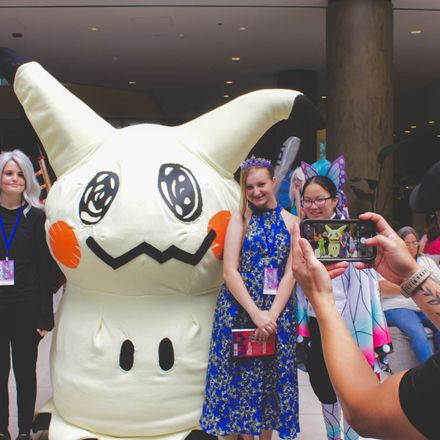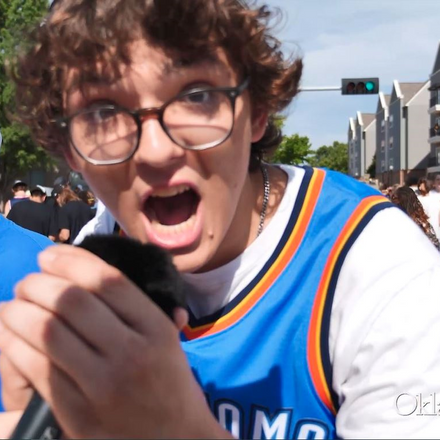Spooky Oklahoma
Published October 2020
By Megan Rossman | 21 min read
Oklahoma’s wild history has produced some truly chilling ghost stories, and a road trip through them is a perfect way to celebrate Halloween in a time of social distancing. Come over to the dark side of the Sooner State.
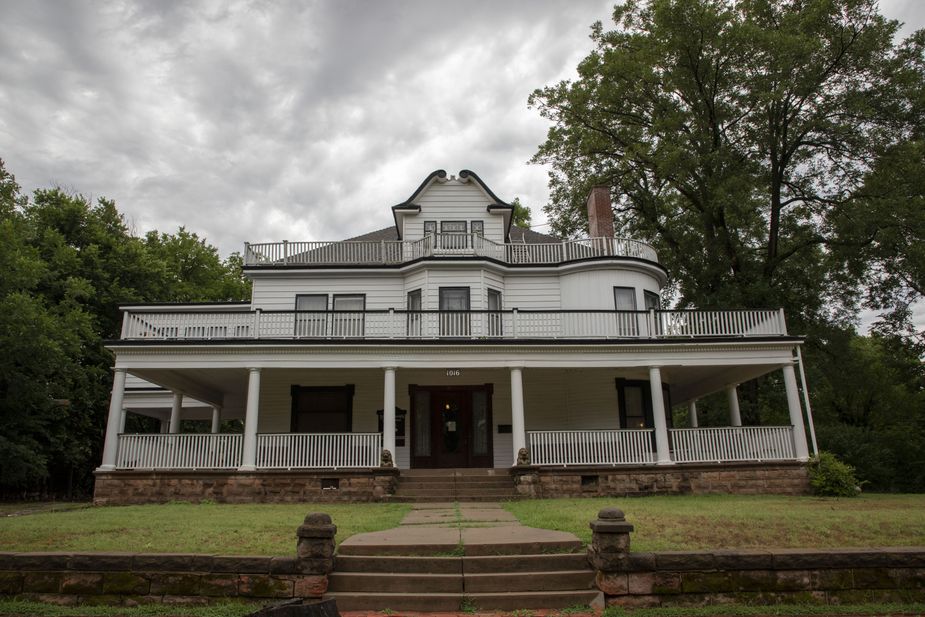
The Stone Lion Inn's Victorian history is apparent in the 1907 home's architectural flourishes and period decor. Whether that history remains in the form of ghosts is up to visitors to decide. Photo by Lori Duckworth
Fright Inn
A Victorian home in Guthrie plays off its creepy reputation to give visitors an experience they won’t forget.
The house has issues’ is my preferred phrase,” says Rebecca “Becky” Luker, who’s owned the Stone Lion Inn Bed and Breakfast in Guthrie since 1986.
When F.E. Houghton built it for approximately $11,000 in 1907, the three-story-plus-basement, 8,000-square-foot home was the most expensive house in Guthrie. The sprawling white mansion houses luxuries like an oak-paneled dining room, lead-beveled bookshelves, three fireplaces, and a 2,000-square-foot basement. According to Luker—and numerous others who’ve visited—ghosts also are among its strange amenities.
“It’s mostly noises and little things you see out of the corner of your eye,” she says of the ghostly activities. “I’ve seen a little cat walking down the hallway many times. When my housekeeper Michelle did laundry in the basement, she would see a man—Mr. Houghton—at the back of the room smoking a cigar in her peripheral vision.”
After Luker bought the home, she spent months renovating and converting it into what’s become a popular bed and breakfast. As she and her young sons worked on the house, the unexplained occurrences around them became hard to keep up with. Children’s toys, carefully put away the night before, would be scattered all over the floor every morning. When they lived on the third floor, they would hear footsteps come up the staircase followed by the sound of a door opening and closing. The tinkling of a music box coming from the wall was another persistent oddity. To this day, Luker’s sons, now in their forties, refuse to step foot in the house.
But Luker herself says none of the paranormal happenings are ever malevolent. Houghton had twelve children who lived in the house, and by all accounts, they were a happy family, though his seven-year-old daughter did die here when she was accidentally overmedicated for whooping cough. Guests who stay in the Cora Diehl Suite sometimes have mentioned being awakened by a child patting their cheeks. Luker says her son Ral sometimes would see a girl about that age playing upstairs.
Ghosts aside, murder mystery dinners held every Friday and Saturday are Stone Lion Inn’s most popular attraction. Set in the 1920s, ’30s, or ’40s, these dinners let guests dig into a seven-course candlelight dinner that includes dishes like green chile bisque and cornish game hens while sorting out who among them is the hidden killer. For an additional fee, participants can book a room for the night for the full spectral experience.
Stone Lion Inn
› 1016 West Warner Avenue in Guthrie
› (405) 282-0012
› stonelioninn.com
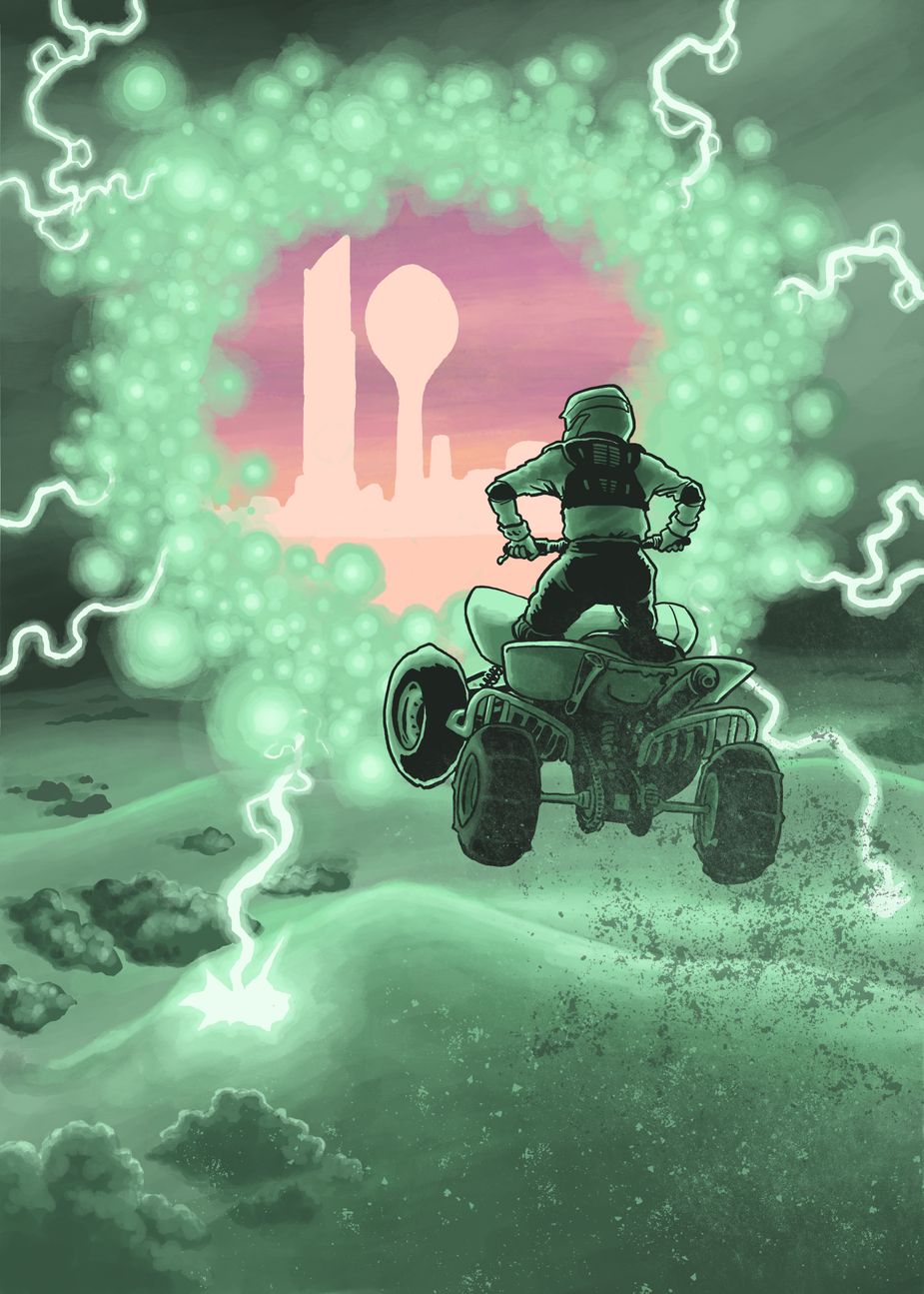
Francisco Vázquez de Coronado set out in the 1540s to find a wealthy civilization known as Quivira. He never found it, but did he discover a portal to another dimension instead in the area known as Beaver Dunes Park? Illustration by Jerry Bennett
Dune and Gone
Is there a portal to another universe in this Panhandle adventure park?
At first glance, few would take Beaver Dunes Park to be a site of ancient mystical power. The sandy slopes of this northwestern Oklahoma attraction near the town of Beaver appeal primarily to free-wheeling ATV enthusiasts who course its 520 acres of sedimentary sprawl. However, hidden somewhere among its hills is rumored to be an otherworldly passage known as Shaman’s Portal or, alternately, Oklahoma’s Bermuda Triangle.
As the story goes, Native American tribes avoided the area and warned the Spanish explorer Francisco Vázquez de Coronado not to go there when he and his party arrived in the mid 1500s. According to online accounts, Coronado evidently disregarded their advice, because they say he then described in his journal three of his men disappearing at the dunes in a flash of green light. However, scholarly studies of this North American expedition don’t mention the incident—which would have been a spectacular claim to not at least acknowledge. Other accounts claim the park is a UFO crash site, and that government agents were seen investigating there in the 1990s. It’s said those who witnessed the alien-related activity were coerced into silence by the federal government.
For the most part though, Panhandle residents laugh at these tales.
“I’ve lived here all my life, and I didn’t know anything about this until about a year ago,” says Beaver County Sheriff Reuben Parker Jr. “I’ve never heard of any animals or people going missing. There are plenty of wrecks out there though, because of the dune buggies.”
While catching some air may be the closest thing to transcendence any visitor at the park has experienced, there are worse ways to spend an afternoon than exploring the dunes. The park also offers RV and tent camping, fishing, hiking, and other activities. So, even if you don’t find a portal, you can still find a good time.
Beaver Dunes Park
› One mile north of Beaver on U.S. Highway 270
› (580) 625-3373

The bridge at Dead Woman's Crossing northeast of Weatherford has been washed away many times, most recently in the 1980s. Photo by Lori Duckworth
Bridge of Insanity
A murder mystery more than a century old—and possibly the ghost of its victim—haunt this INfamous bridge outside Weatherford.
Unlike many urban legends and ghost stories, Dead Woman’s Crossing near Weatherford has a verifiable backstory.
In July 1905, with her year-old daughter Blanche “Lulu Belle” in tow, Katie (or Katy) DeWitt James boarded a train to visit relatives. According to reports, it was two days before or after her departure that James filed for divorce from her husband, a wealthy farmer, and sought sole custody of their child. She never made it to her destination. James’ father Henry, who bade her farewell at the station, was the last family member to see her alive.
Information pieced together over the weeks that followed indicates James inexplicably disembarked in Weatherford with Mary Francis “Fannie” Norton, a reputed prostitute also known as Mrs. Ham. One report says James stayed the night with her at the home of Norton’s brother-in-law before the women and baby were seen riding together in a livery wagon near a local stream known as Deer Creek on the morning of July 7.
As days passed, and no one heard from James, her father hired private detective Sam Bartell of Oklahoma City to look into her disappearance. On July 24, Bartell found Katie’s daughter Blanche in the care of a German family near Weatherford. According to a story in the Daily Oklahoman, the family said a woman matching Norton’s description had arrived on their property in the wagon early on July 7 and handed the baby—unharmed and healthy—to their youngest son, asking him to have his mother look after her until she returned from town in a few hours. Norton departed in a hurry, and he noticed her toss out a bundle of what he discovered to be the baby’s clothes soaked in someone else’s blood. Norton, of course, did not return for the baby, and it’s unclear why weeks went by without anyone in the family reporting what must have seemed to them a strange incident.
A few days later, Bartell arrested the notorious Mrs. Ham in Shawnee. She denied having killed Katie James, insisting she transferred her to another party’s wagon. She then fatally poisoned herself in the police station hours after being taken into custody—no one knew where she got the poison. It was not until August 31 that a hunter happened upon James’ summer-scorched remains hidden in a bush near the bank of Deer Creek northeast of Weatherford. Some accounts say she was found decapitated, but the official cause of death was a gunshot wound to the head from a .38-caliber pistol found nearby. Days after her body was discovered, a Custer County jury ruled the death a homicide at the hands of Fannie Norton. Adding another layer of tragedy to the story, her daughter Blanche died of polio in 1913 at the age of eight and is buried in a Dewey County cemetery.
Was it a robbery gone awry? Did Fannie act alone, or was she innocent? Was it a murder for hire? Why was the baby spared? Questions and theories proliferate still among internet sleuths looking to dig deeper into the mystery.
Those questions are unlikely to be answered, but the location of Katie’s demise—known as Dead Woman’s Crossing—exerts a paranormal allure over those in search of scares. Local lore says a baby sometimes can be heard crying from the banks of the creek below the overpass, and others have claimed to see orbs of light in the vicinity. Some even say they’ve heard wagon wheels and a woman calling out in the night. Whether these reports are the tall tales of bored teenagers or something more is debatable, but the gruesome and devastating murder that took place here is no matter of legend.
Dead Woman’s Crossing
› To find Dead Woman’s Crossing, take exit 84 from I-40, drive half a mile north to the stop sign, go a quarter-mile east from there, and then take the blacktop road half a mile to the bridge.
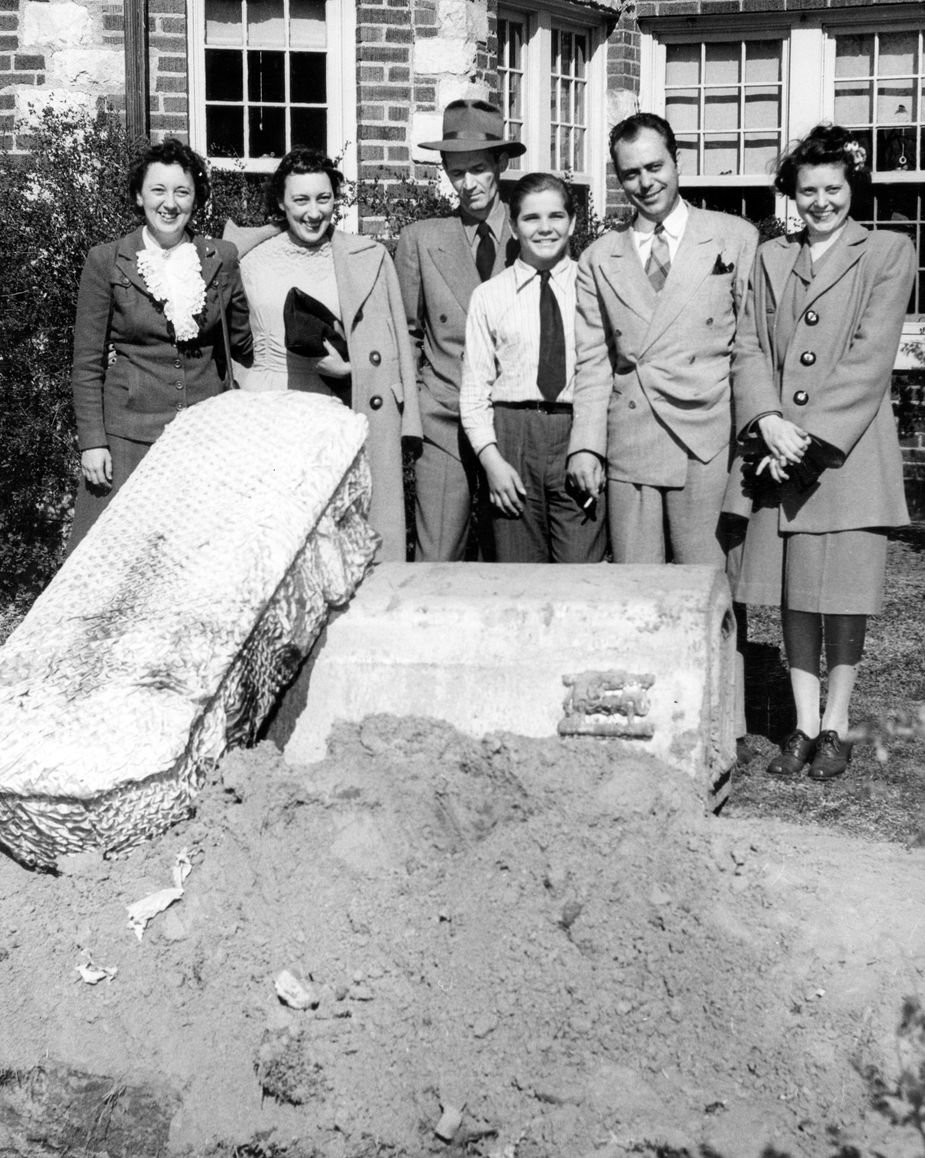
From left to right: Marion Sample, her sister Virginia Evans, Deputy W.S. Duggins, house resident Bobby Gene Fowler, Paul Horner, and his sister Willetta Horner pose next to unearthed dog coffins at the Hex House in Tulsa after the two women were freed. Photo courtesy Tulsa World
Hex and the City
Whatever Carolann Smith was in early twentieth-century Tulsa—Cult leader? Evil witch?—she left a creepy legacy behind.
Carolann Smith lived well. She collected expensive perfumes and clothes, drove a fancy automobile, and was known in Tulsa’s upper-class social circles. She resided in a luxury duplex at East Twenty-first and South Main streets. But despite her baubles, Smith was a bit of a miser. She hoarded shoes and makeup and applied for wartime rations under various names that included one of her dogs. It was this bit of fraud that led to much bigger legal problems, when neighbors told investigating police they had seen someone burying a casket in her backyard. A warrant was issued, and the police dug up two small coffins in the backyard containing two of Smith’s dogs.
The bigger surprise, however, was the two women they discovered in the basement. Sleeping on crates and wearing rags, Willetta Horner and Virginia Evans—both in their early thirties—were the exclusive members of Carolann Smith’s own homespun cult. Brainwashed into believing Smith would get them into heaven, the women had lived for years as her slaves. Evans’ father had even given Smith around $17,000 thinking his daughter had become ill and needed medical care.
Other duplex tenants said the younger women were nightmare neighbors who screamed, growled, and even threw scalding water on them—supposedly at the behest of Smith. Of course, this woman’s eerie chicanery didn’t end with Horner and Evans. In addition to what she squeezed from them, the primary source of her income appeared to be payouts from life insurance plans she had taken out on her late husband and father. Her husband had killed himself—some said at her incessant urging—and her father unexpectedly died just before he was supposed to come live with her. She had even tried to collect an insurance claim on her maid. It’s reported Smith also had taken out policies on the girls shortly before police located them, indicating she intended to send them to heaven sooner than they expected. Teri French, author of Tulsa’s Haunted Memories, writes that there were at least seven suspicious deaths among people acquainted with Smith.
As soon as the story broke, the strange news made its way into many local newsrooms. According to the Tulsa World, in October 1944, Smith “was found guilty of inducing the two younger women to testify falsely against a neighbor and sentenced to a year in prison following a three-day trial.” The same article also states she pleaded guilty to fraud related to her wartime ration book.
It’s unclear what became of Smith after that. Horner and Evans are said to have readjusted to life pretty well after they were “hexed.” After Smith was arrested, the two women appeared smiling and bright-eyed in news photos outside their former prison.
The infamous house eventually was razed in the 1970s to make way for a parking lot. The lot’s stone border and the staircase leading from the sidewalk still remain—the basement is buried under the concrete lot—across from Veterans Park.
Hex House
› The Hex House was located at 10 East Twenty-first Street in Tulsa.
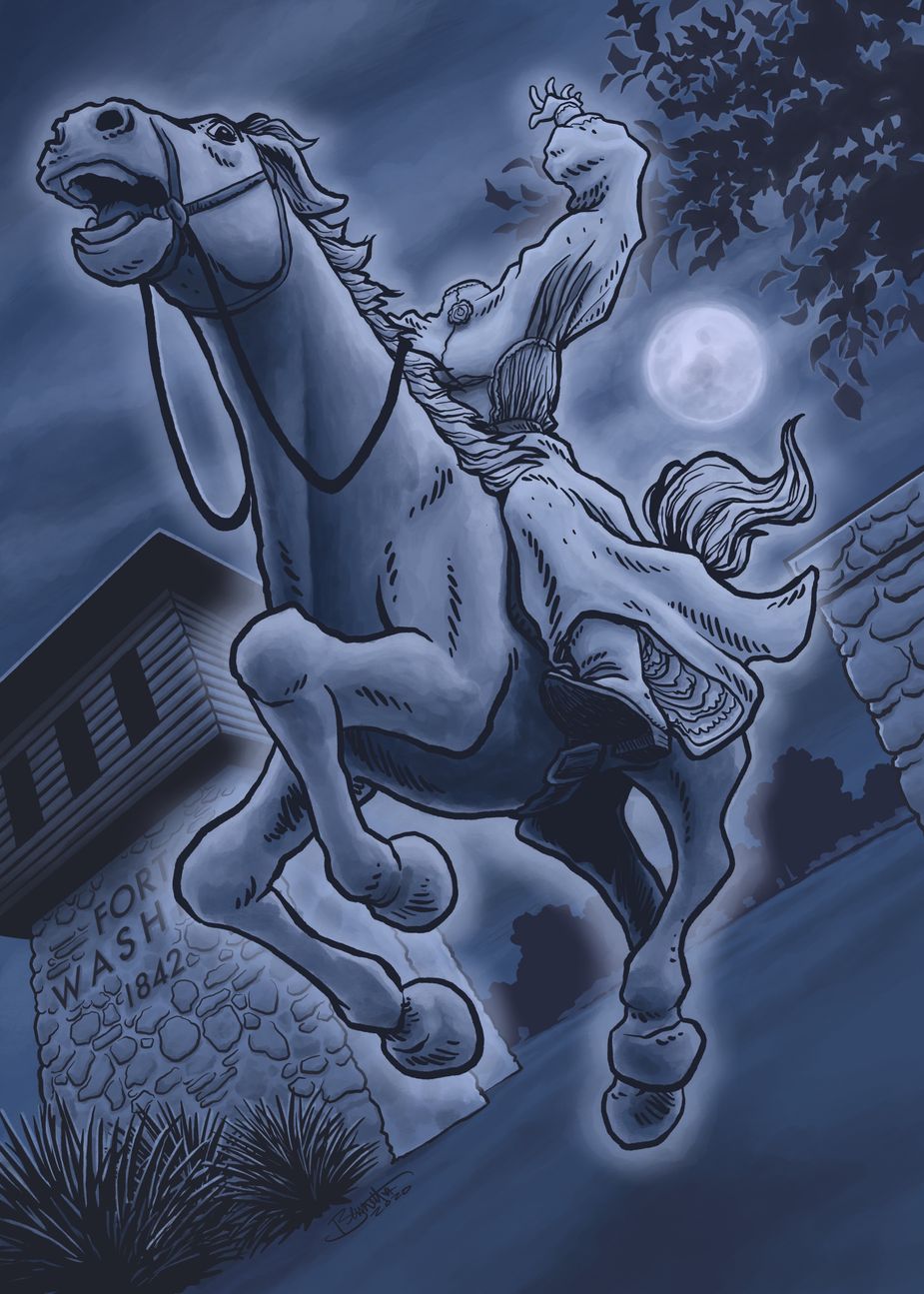
No one knows for sure who the ghost called "Aunt Jane" really is, but if she exists, she appears to be paranormally preoccupied with making life difficult for those not yet deceased. Illustration by Jerry Bennett
Fort of Fear
Does this southeastern Oklahoma military outpost still house the spirit of a murdered woman?
Fort Washita was established in 1842 as a U.S. military outpost intended to protect the Chickasaws and Choctaws from attacks by Plains tribes and hostile white folks. After being abandoned at the start of the Civil War, it served as a residence for Confederate soldiers but was left in charred ruins when they deserted a few years later.
But some buildings still remain at this National Historic Landmark owned by the Chickasaw Nation near Durant, and, according to some, they’re home to a few ghostly tenants. The most notorious among them is Aunt Jane. Whether she was an officer’s wife or a freed slave from the North is contested, but stories claim she was murdered for her gold by soldiers or passing thieves, either beheaded or dismembered, and buried somewhere on the site. Both a headless figure and one on horseback with long black hair seen at the fort have been understood to be Jane’s ghost.
And she seems to hold a grudge against the living. Following the Dawes Act and the Atoka Agreement in 1897, the Colbert family was allotted the property and transformed the barracks into their home. Accounts of their tenure vary—the barracks burned down in 1917, but the family appears to have retained the property until 1962, when the Oklahoma Historical Society took ownership of the fort. While the Colbert family lived on the property, something odd appeared to be happening. All of Charles Colbert’s thirty-two dogs went missing and had to be rounded up two nights in a row, and the family is said to have moved out of the barracks shortly thereafter.
Before its sale, other tenants on the property in the early twentieth century—a brother and sister with the surname Steele—supposedly experienced general harassment of what appeared to be a ghostly nature. This ended with the sister having a nervous breakdown. Since then, visitors have reported seeing apparitions wandering the property, and several women who stayed there overnight reported the sensation of being observed and even strangled by an unseen force.
In keeping with its paranormal reputation, Fort Washita offers candlelight ghost tours organized by the Oklahoma Historical Society each October, where guests can sip on cider and learn more about the lingering spirits in their midst. This year’s tours have been canceled due to COVID-19, but the fort will be up and running post-pandemic and ready to welcome any Okies in search of a good historic scare.
Fort Washita Historic Site and Museum
› 3348 State Highway 199 in Durant
› (580) 924-6502
› chickasaw.net

